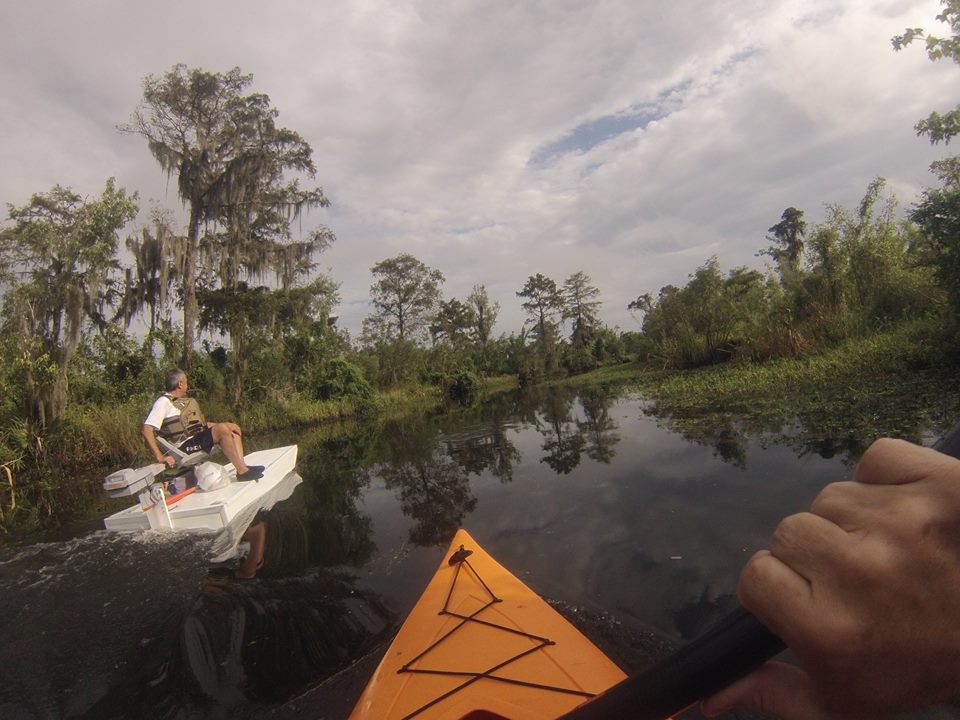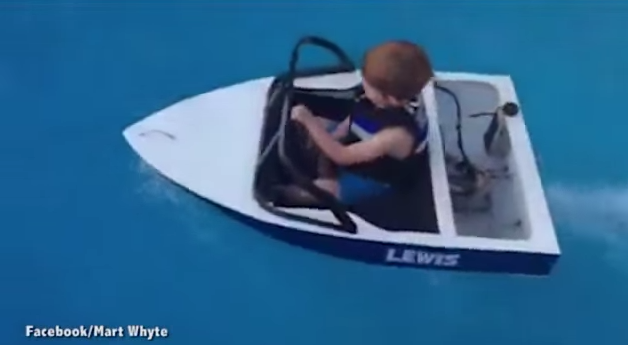An inventor from East London has created FloatSki, a device that allows users to walk on water. Watch it in action here
An inventor from London has developed a commercial device to allow people to walk on water – by combining the latest surfboard materials with aviation technology based on a Boeing 787 Dreamliner jet airliner.
Lifelong rowing and windsurfing fan Kris Rogus, 42, has been attempting to devise a system for taking a watery stroll since he first tried it as a teenager by attaching two kayak boats in his native Poland.
And after spending the last five years working during all his spare time to turn his hobby into a business, Rogus has come up with a device based on two skis with an intricate set of fins, flaps and hinges, described in his worldwide patent as ‘water walking apparatus with improved propulsion’.
He is now looking for funding to get his FloatSki creation off the ground – and into the water – after trialling it at London’s Hyde Park this summer.
Kris, who has lived in East London since 2003, says the creative atmosphere in the area helped his initial attempt to come up with a device for walking on water.
“I met lots of great people when I first moved here from Poland, with lots of weird and wonderful projects, all of which gave me the original confidence to turn my dream into reality.”, says the inventor.
“FloatSki started as a hobby – I was passionate about rowing and surfing as a teenager, and had always been keen on creating something which would allow me to walk on water.
“One day in a London surf shop I spontaneously bought a high quality foam surfboard. I knew I wanted to experiment with materials, foams, resins, stability and mechanism, to create something light, safe and reasonably fast for the water and which also looked attractive – so I got to work in my spare time and at weekends.”
Kris has poured his life savings into the project. He’s been renting a workshop, bought materials for production, secured a European patent protection for his design, and even has the support of Cornwall’s UK surfing industry legend Tris Cokes.
All the mechanical parts – composite materials, carbon fibre and epoxy resin – are expertly hand crafted in Kris’s workshop in Bethnal Green, where final assembly also takes place.
Working with Tris Cokes, Rogus developed his design, using epoxy resin and EPS foam – while all the mechanical parts have been made from carbon fibre, using the same technology as Boeing’s mid-size, long-haul jet airliner, which resulted in reducing the weight of each ski to around 10kg.

“FloatSki is the first ever device which enables the user to walk on the surface of water, and it’s ready for commercial use. It’s fast, stable and easy to use, and only a basic level of fitness is required. More than anything else, it’s great fun.”, says the 42-year-old.
“According to The Royal Yacht Association, over 3.2 million people in the UK actively engage in the water sports industry, including canoeing, kayaking, surfing, windsurfing, yachting and power boating – and I want to reach out to all of them, initially with the aim of finding a venue for FloatSki in central London.”
The inventor says an experienced user can use FloatSki to walk on water at around 5-6 km/hour, which is similar to normal walking speed, while the addition of poles allows the user to get up to 7-8 km/hour – and he is even working on a way to perfect running on water.
Rogus added: “I have a unique product which needs a great location. We trialled it at Hyde Park this summer (2016), where it did well, and they are interested in taking it a step further next year, but now I need to crowdfund. I’ve taken this project as far as I can without any backers.”
There have been several attempts to create devices to walk on water. An American inventor came up with WaterBlade, a floating platform created for fitness, and let’s not forget what is possibly the very first design for walking on water: Leonardo Da Vinci’s ‘water shoe’, designed in the 15th century.
Will Floatski succeed where others haven’t?
“The global surfing industry is worth $13.2 billion a year, and stand up paddling, which is my nearest competitor, is worth almost $2 billion – and there is a lot of potential with FloatSki.”, concludes Rogus optimistically.
The SolarSkiff comes in single, double and four-person versions, with prices starting from $3,500. YBW talks exclusively to its creator,… Quiet and efficient, the Trondheim 40 Trawler has been designed by the Russian Max Zhivov, who is known for creating… An Australian man has built a mini-speedboat from scratch for his nephew.Pictures: SolarSkiff affordable electric boat that fits on top of your car
Pictures: World’s first electric powered trawler is unveiled
Video: Mini-speedboat for Christmas … best kids gift ever?






